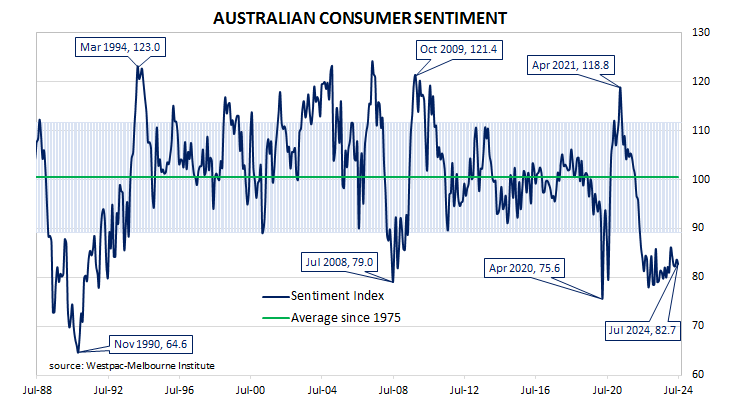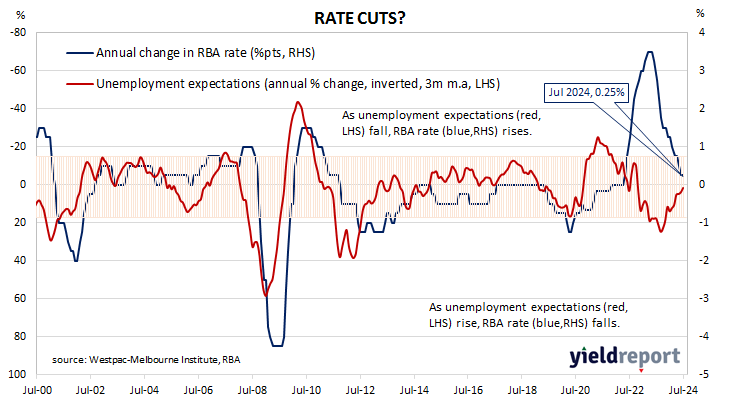Summary: Westpac-Melbourne Institute consumer sentiment index declines in July; Westpac: sentiment stuck in deeply pessimistic range for 2 years; ACGB yields decline; rate-rise expectations soften; Westpac: persistent inflation, further interest rate rises fears offsetting tax-cut boost; two of five sub-indices lower; fewer respondents expecting higher jobless rate.
After a lengthy divergence between measures of consumer sentiment and business confidence in Australia which began in 2014, confidence readings of the two sectors converged again in mid-July 2018. Both measures then deteriorated gradually in trend terms, with consumer confidence leading the way. Household sentiment fell off a cliff in April 2020 but, after a few months of to-ing and fro-ing, it then staged a full recovery. However, consumer sentiment then weakened considerably and has languished at pessimistic levels since mid-2022 while business sentiment has been more robust.
According to the latest Westpac-Melbourne Institute survey conducted over the first week of July, household sentiment has deteriorated, partially reversing a modest improvement in June and maintaining a level which is quite pessimistic. Their Consumer Sentiment Index declined from June’s reading of 83.6 to 82.7, a reading which is significantly lower than the long-term average reading of just over 101 and well below the “normal” range.
“Sentiment remains stuck in the same deeply pessimistic range that has dominated for two years now,” said Westpac senior economist Matthew Hassan.
Any reading of the Consumer Sentiment Index below 100 indicates the number of consumers who are pessimistic is greater than the number of consumers who are optimistic.
Australian Commonwealth Government bond yields declined modestly across the curve on the day. By the close of business, the 3-year ACGB yield had slipped 1bp to 4.08% while 10-year and 20-year yields both finished 2bps lower at 4.35% and 4.68% respectively.
Expectations regarding rate rises in the next twelve months softened a touch. Cash futures prices at the end of the day implied the cash rate has some chance of rising above the current rate of 4.34% in the short-term, with an average of 4.39% in August, 4.45% in November and 4.425% in February 2025. However, May 2025 contracts implied 4.32%, 2bps less than the current cash rate.
“The July update shows that fears of persistent inflation and further interest rate rises are again weighing more heavily on the consumer mood,” added Hassan, “offsetting any boost from the arrival of the ‘stage 3’ tax cuts and other fiscal support measures.”
Two of the five sub-indices registered lower readings, with the “Family finances versus a year ago” sub-index posting the largest monthly percentage loss.
The Unemployment Expectations index, formerly a useful guide to RBA rate changes, fell back from 133.1 to 128.6, in line with the long-term average. Lower readings result from fewer respondents expecting a higher unemployment rate in the year ahead.



